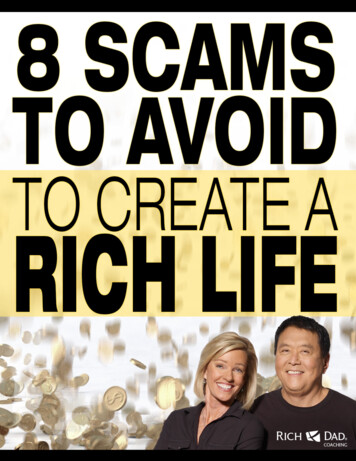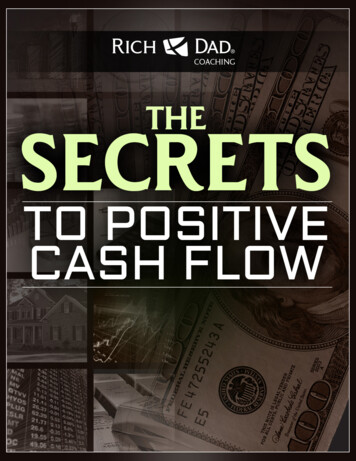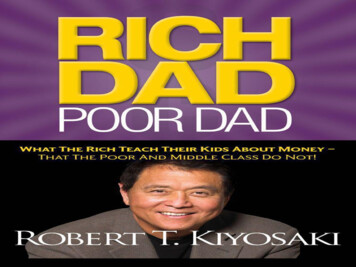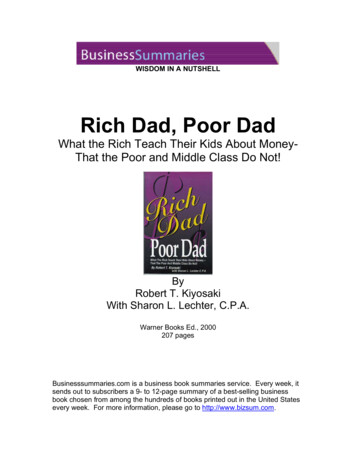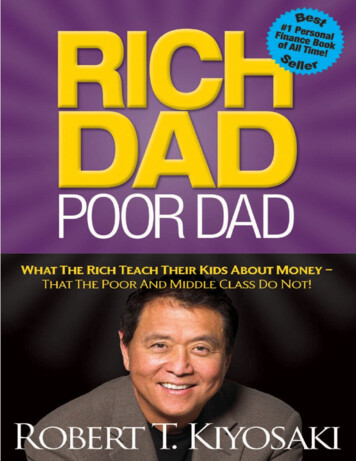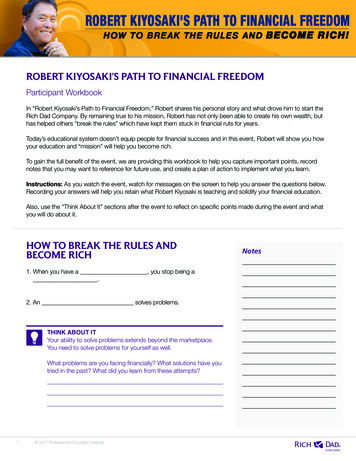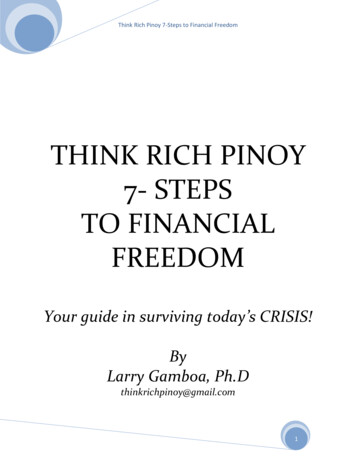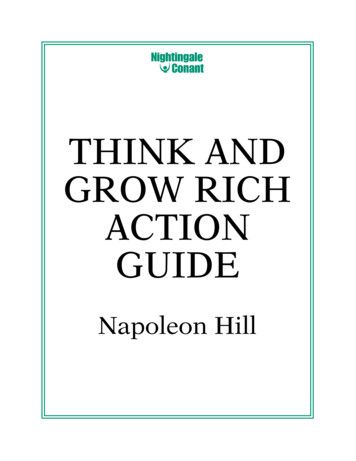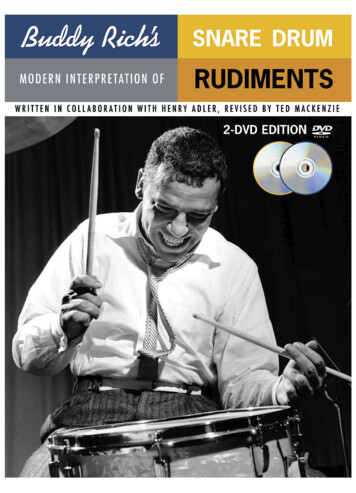
Transcription
BuddYRich'sModern tnterpretation- ofSnare DrumRudimentsCopyright l 942 (Renewed) by Embassy Music Corporation,A Division of Music Sales Corporation, New York, NY.Ali rights reserved. No part of this book may bereproduced in any form or by any electronic or mechanical meansincluding information storage and retrieval systems,without permission in writing from the publisherexcept by a reviewer who may quote briefpassages in a review.Internacional Standard Book Number: 0.8256.2203.4Library of Congress Catalog Card Number: 43-10667Exclusive Distrihutors:Music Sales Corporation225 Parle Avenue South, New York, New York 10003 USAMusic Sales Limited8/9 Frith Street, London Wl V 5TZ EnglandMusic Sales Pty. Limited120 Rothschild Street. Rosebery, Sydney, NSW 2018. AustraliaPrinted in the United States of Amenca byVicks Lithograph and Printing Corporat1onAmsco Publications\:ew Y"rk 10ndnn ;;,·rlnf:''"
ContentsForeword . . . . . . . . . . . . . . . . . . . . . . . . . . . . . . . . . . . . . . . . . . . . . . . . . . . . . . . . . . . . . . . . . . . . .3Introduction . . . . . . . . . . . . . . . . . . . . . . . . . . . . . . . . . . . . . . . . . . . . . . . . . . . . . . . . . . . . . . . . . . . 3Selecting the Drum Sticks . . . . . . . . . . . . . . . . . . . . . . . . . . . . . . . . . . . . . . . . . . . . . . . . . . . . . . . . . 4Toe Practice Pad. 4Holding the Drum Sticks . . . . . . . . . . . . . . . . . . . . . . . . . . . . . . . . . . . . . . . . . . . . . . . . . . . . . . . . . 4Hand, Wrist and Arm Action5Elementary Principies of Music . . . . . . . . . . . . . . . . . . . . . . . . . . . . . . . . . . . . . . . . . . . . . . . . . . . . . 6Development of the Hands, Lession 1 . . . . . . . . . . . . . . . . . . . . . . . . . . . . . . . . . . . . . . . . . . . . . . . . .13Alternate Single Strokes, Lesson 2 . . . . . . . . . . . . . . . . . . . . . . . . . . . . . . . . . . . . . . . . . . . . . . . . . . .13Accen ts, Lesson 3 . . . . . . . . . . . . . . . . . . . . . . . . . . . . . . . . . . . . . . . . . . . . . . . . . . . . . . . . . . . . . . .1416The Three Stroke Ruff, Lessons 4, 5, 6, 7 . . . . . . . . . . . . . . . . . . . . . . . . . . . . . . . . . . . . . . . . . . . . .18The Four Stroke Ruff, Lessons 8, 9, 10, 11 . . . . . . . . . . . . . . . . . . . . . . . . . . . . . . . . . . . . . . . . . . .20The Five Stroke Ruff, Lessons 12, 13, 14 . . . . . . . . . . . . . . . . . . . . . . . . . . . . . . . . . . . . . . . . . . . . .The Five Stroke Roll, Lessons 15, 16, 17, 1822.24The Seven Stroke Ruff, Lessons 19, 20, 21.The Seven Stroke Roll, Lessons 22, 23, 24, 25 . . . . . . . . . . . . . . . . . . . . . . . . . . . . . . . . . .· . . . . . . 25The Nine Stroke Ruff, Lessons 26, 27, 28. ·,., . · .· · . . . . . · , , · · , · · , -2728The Nine Stroke Roll, Lessons 29, 30, 31, 32.Roll,.DoubleStrokeLesson33·30The.The Single Stroke Roll, Lesson 34 . . . . . . . . . . . . . . . . . . . . . . . . . . . . . . . . . . . . . . . . . . . . . . . . . . .32Toe Press Roll, Lesson 3 5 . . . . . . . . . . . . . . . . . . . . . . . . . . . . . . . . . . . . . . . . . . . . . . . . . . . . . . . . .33The Single, Double and Triple Paradiddles, Lessons 36, 37, 38, 39, 40, 41, 42 . . . . . . . . . . . . . . . . .33The Flam, Lesson 43.36The Single, Double and Triple Flam Paradiddles, Lessons 44, 45, 46 . . . . . . . . . . . . . . . . . . . . . . . . .36The Flam Tap, Lessson 47 . . . . . . . . . . . . . . . . . . . . . . . . . . . . . . . . . . . . . . . . . . . . . . . . . . . . . . . . .37The Flam Accent, Lesson 48 . . . . . . . . . . . . . . . . . . . . . . . . . . . . . . . . . . . . . . . . . . . . . . . . . . . . . . .37The Flamacue, Lesson 49 . . . . . . . . . . . . . . . . . . . . . . . . . . . . . . . . . . . . . . . . . . . . . . . . . . . . . . . . .3838The Half Drag, Lessons 50, 51, 52, 53 . . . . . . . . . . . . . . . . . . . . . . . . . . . . . . . . . . . . . . . . . . . . . . .40The Single, Full and Double Drags, Lessons 54, 55, 56 . . . . . . . . . . . . . . . . . . . . . . . . . . . . . . . . . . .42The Single, Double and Triple Drag Paradiddles, Lessons 57, 58, 59, 60 . . . . . . . . . . . . . . . . . . . . .Toe Three Stroke Ruff Single, Double and Triple Paradiddles, Lessons 61, 62, 63, 64 . . . . . . . . . . . 44The Four Stroke Ruff Single, Double and Triple Paradiddles, Lessons 65, 66, 67, 68 . . . . . . . . . . . 46The Single, Double and Triple Ratamacues, Lessons 69, 70, 71, 72, 73, 74, 75, 76, 77 . . . . . . . . . . . 48Toe Compound Strokes, Lessons 78, 79, 80, 81, 82 . . . . . . . . . . . . . . . . . . . . . . . . . . . . . . . . . . . . .53Exercises in Triplets, Lesson 83.54Reading Exercises.5778Explanatory Remarks Concerning Exercises Employing Rudiments . . . . . . . . . . . . . . . . . . . . . . . . .Exercises Employing Rudiments.79.·Buddy Rich in Action· · · · · · 89· . . . . . . 90Advanced Rhythmic Studies . . . . . . . . . . . . . . . . . . . . . . . . . . . . . . . . . . . . . . . . . . . . . . . .Musical Terms . . . . . . . . . . . . . . . . . . . . . . . . . . . . . . . . . . . . . . . . . . . . . . . . . . . . . . .· · · · . · · . . 96
ForewordThe circumstances surrounding the conception and publication of Buddy Rich 's Modem Interpretation O f Snare DrumRudiments were quite unusual. The thought of writing a drumbook had never occurred to Mr. Rich, until he was suddenlyinspired to do so through the vast number of inquiries hereceived from drum students and teachers from all parts ofthe country. He soon discovered, however, that his duties withthe Tommy Dorsey organization would not allow him sufficient time to devote to writing a drum method, especiallyif the book called for early publication. Therefore, he immediately contacted his instructor and friend, Henry Adler the well-known authority on percussion instruments - whoagreed to collaborate with him in the compilation and preparation of such a work.The result of the combined efforts of the Rich-Adlerpartnership is a book with all the fundamental material neededfor an instructive drum method. In addition to the elementaryprincipies of music, there are eighty-three lessons o f exercisesand rudiments, twenty-one reading exercises, ten exercisesemploying rudiments, forty-six advanced rhythmic studies anda list of the most frequently used musical terms. All of thematerial has been carefully graded as to difficulty.Buddy Rich's Modern Interpretation of Snare Drum Rudiments not only differs from all other drum books, in that itcontains a systematic course for the beginner, but it is alsoof great value to the teacher and professional who wishes toincrease his knowledge of the rudiments.When Mr. Rich approached us in reference to the publication of this work, we accepted it with a complete knowledgeof his ability and genius in the drum world. We had perfectconfidence that the book would prove to be an outstandingcontribution to drum literature.The Publisherslntroductionby Tommy DorseyIt is the opinion of the general public, especially of thosewho do not understand the importance and qualifications ofa drummer, that he does not necessarily have to be a musicianto play in a band or orchestra. They think that it is not necessary for a drummer to read music, that he is engaged merelyto maintain tempi, and to beata variety of rhythmical strokesas loudly as possible. This is false reasoning in regard to successful drurnmer.In arder to attain the height o f his profession, a drummermust be as good a musician as any member o f a band ororchestra. Not only is it important that he read music, but heu,ust also have a solid background in the art of drumrning;that is to say, he must be well versed in al! of the rudiments.However, it might be well forme to state here that a drummeris often called upon to improvise a suitable part, because of themany faulty parts written by arrangers. Most of the drumparts, especially a great number of those in dance arrangements, are written as "guide" parts, leaving it entirely to theingenuity of the player to use his own judgment.It is true that a drummer can make more noise than anyother member in the band, but 1n intelligent, capable drummer never goes to extremes in this respect; he carefully follows the dynamics, accents, etc., of the arrangernent and styleof the cornposition i.i1 bringing out the various. necessary effects. At no time can a drummer do as he please, when it comesto playing louder than the music calls for; but his finesse ininterpolating the various rudiments is always appreciated.Most important of all, of course, is for a drummer tomaintain a strict tempo. Nothing irritates a conductor morethan for the drummer to play an irregular tempo - a tempothat constantly varíes from fast to slow and vice versa.The drummer who cannot read music, sooner or later, willbe put through a test where he will be asked to read his partexactly as it is written or seek employment elsewhere. This isespecially true of the drummer who plays in theatre, concert,school or symphony orchestras, or in concert bands.Buddy Rich, the drummer supreme, has been with me forsorne time; and whether he is reading his drurn part or creatingone of his own, his handling of the drums and various trapsshows the work of a genius.Buddy Rich, even with his natural ability and talent, knewthat, in order to become eminently successful, it would benecessary for hirn to gain the appropriate training. He had theforesight to engage a competent teacher, so that he would not,later on, have to overcome or undo any faulty habits.In selecting Henry Adler to instruct him, Buddy Richshowed good judgment, for Mr. Adler has had great success indeveloping young drum studen ts. In this connection, I alsowish to say that Buddy Rich was extremely fortunate insecuring Mr. Adler's assistance in the preparation o f this drummethod - a rnethod which I' feel sure will become a standardwork in this field of instruction.3
Se/ecting The Drum SticksWhen selecting the proper drum sticks, four extremelyimportant features must be taken into consideration - size,weight, levelness and balance.Toe size of the sticks is judged by the size of the student'shands; if his hands are large, he will naturally, need a largerpair of sticks than if his hands are small.Toe weight of the sticks is deterrnined by placing a stickin each hand and turning the wrists from side to side, severaltimes. Toen, if the sticks do not feel perfectly comfortable,as to the weight, other sticks should be tested, until the properpair is found. It is also necessary that the sticks weigh thesame; therefore, each stick should be weighed separately.Toe levelness of the sticks is best tested by rolling them onthe glass counter in the store. If, during this test, the sticks donot roll evenly, or have a tendency to wobble, they should berefused.Toe center of balance should be a distance of about twothirds from the knob (tip) of the stick, at the exact spotwhere it is held with the thumb and first finger. A good wayto determine the center of balance is to hold the sticks in thecorrect manner and agitate the wrists with a motion similarto that used in executing the "bounce." (See Lesson 33, p. 30)Various wen:seasoned woods are used in the manufacture ofdrum sticks, but it is conceded by experts that bickory is themost satisfactory wood because of its durability and tone. Toehardness of the wood denotes the tone. Naturally, a hard stickwill have a sharper, crisper tone than a soft stick. A good hardstick has a twofold purpose; first, it is easier to handle andsecond, it gives a firmer stroke.Drum sticks also come in a variety of stains, and with different shaped knobs (tips) and tapers, the choosing of whichis a purely personal matter. None of these points, however, areas important as the size, the weight, the levelness and thebalance.After the proper pair of sticks has been selected, it issuggested that each stick be given a final test so as to insurea perfect match.The Practice PadToe best means of acquiring drum technique is to practicewith the aid o f a pad known as a practice pad./See illustration.JToe practice pad is a small wooden contraption on topof which is cemented a rubber disk, or mat, forming the striking surface. In seiecting the pad, particular attention should bepaid to the quality of the rubber used for the disk which canbe tested by tapping it with the drum sticks to see that theproper resiliency (bounce ). If the rubber is soft or spongy, thesticks will not rebound quickly.Toe purpose of a practice pad is threefold. First, the strokesare more pronounced than they are on a drum - every tapbeing clear and distinct. Second, it eliminates noise - thestrokes being barely audible. Third, it is not as cumbersomeas a drum.Toe practice pad is manufactured in two different models:the table model and the stand model.4After leaming the rudiments on a practice pad, the studentmay then apply them to the snare drum. He will, at first,discover a slight difference in the technique required for"plucking" the various strokes off the drum but, with a littlepractice, this difference can shortly be remedied.In the following pages no further reference is made to thepad, because it is understood that the student will substitutethe pad for the drum, at least, until he has gained perfectcontrol of the sticks through accurate action o f the hands,wrists and arms.practice padHolding the Drum SticksTo the novice, it
The thought of writing a drum book had never occurred to Mr. Rich, until he was suddenly inspired to do so through the vast number of inquiries he received from drum students and teachers from all parts of the country. He soon discovered, however, that his duties with the Tommy Dorsey organization would not allow him suf- ficient time to devote to writing a drum method, especially if the book .
